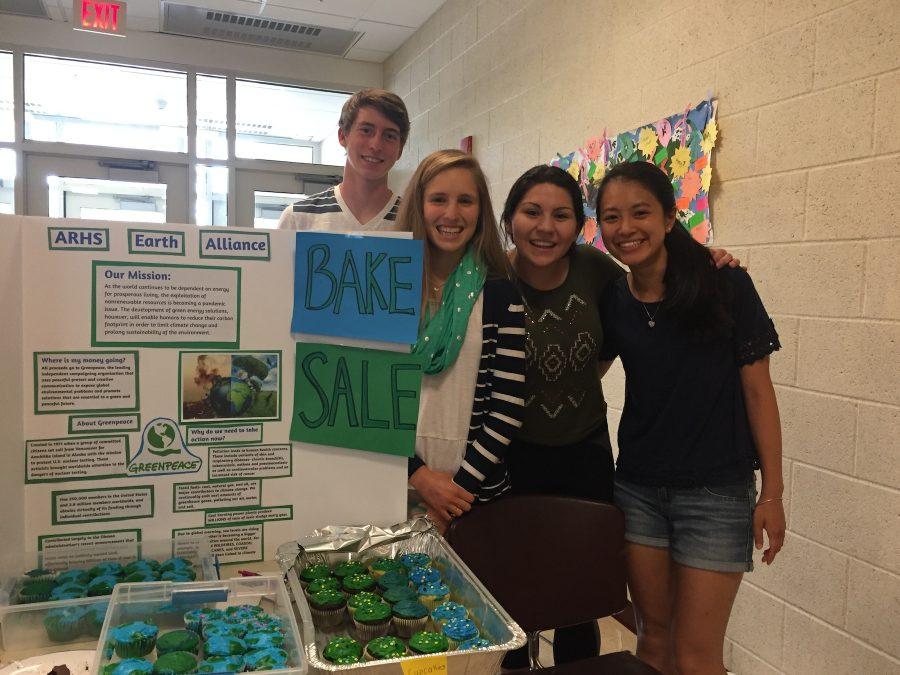AP World History students raise awareness about global issues
Juniors Everett Pirtle, Gretchen Forbush, Gabi Thompson, and Katelyn Li raise money and awareness for climate change through a bake sale.
June 7, 2016
AP World History students are researching and coming up with solutions to current world problems for the annual Global Initiative project.
The AP World History curriculum covers everything from the beginning of the Agricultural Revolution to the twenty-first century. The final assignment, a Global Initiative project, is a culmination of the year, according to social studies teacher Nathaniel Uttaro. For the project itself, AP World students tackle global issues and attempt to solve them, based off of research, what successful organizations are doing, and expert opinions.
“With the AP Exam [finished], that leaves us a month to talk about the future, what the future holds, what interests you, and how you can do something about it,” Uttaro said. “The project is an opportunity for the students to really try to get in depth with their chosen topic.”
Topics that students can choose from include education, the drug trade, malaria, human trafficking, and many others. From there, students work at the local level to fundraise through bake sales and promote their cause through posters and social media. Then, groups will send those donations to an organization of their choice that can then make a global impact.
Juniors Noah Brazer and Annalise Eppen are researching immunization for their Global Initiative project.
“We are trying to understand the problems which lead to people not being able to obtain vaccines or vaccines that aren’t as effective as they could be,” Brazer said.
The project has made students more aware of world issues, as well as the scale of these issues.
“[The project] also puts into perspective how effective programs in the United States are,” Brazer said. “I didn’t know this before, but huge problems such as the delivery of vaccines are due to problems with infrastructure because vaccines require so much care to transport and in the United States it’s just so easy to transport drugs and make them available.”
To spread the word out about their cause, different groups have advocated their cause through different social media platforms, such as Instagram, Twitter, as well as Google Forms so that people may pledge their support to bettering immunization.
For Brazer, the biggest challenge in successfully executing the project is to make people more aware of this issue.
“The most difficult thing is to actually make a meaningful impact, because anybody can just go online and type their name [to sign a petition] and not think about it, but I feel like the goal of this project is to raise awareness and make you think about the privileges that you have,” Brazer said. “I feel like that’s really hard: trying to help other people think about those privileges.”
Eppen hopes that her group continues to stay aware about immunization, especially after completing the project.
“The most important thing is that [our group] stays passionate about our topic and that we don’t forget about it,” Eppen said. “I’m so into all these different problems now because there are so many issues out there, and I hope that everyone stays involved and keeps spreading awareness.”
Uttaro believes that the most important thing students can gain from this project is to be more aware about the events that are happening around them.
“The key thing is to raise awareness,” Uttaro said. “Algonquin students tend to be a little bit sheltered and they don’t know much about the outside world, so their knowledge is fairly limited in terms of what’s going on in the world.”
Uttaro believes that ultimately, the goal of the AP World Global Initiative project is not focused on the money, but rather serves as a medium for students to understand problems across the world and to spread that word throughout the community.
“This is a chance for [students] to talk to their peers and talk to their families and really try to raise that awareness. Some of that comes through fundraising, spreading the message, soliciting some donations, then those donations will go to the organizations,” Uttaro said. “The be-all-and-end-all isn’t how much money they raise, it’s more about trying to raise awareness.”









